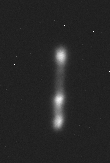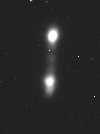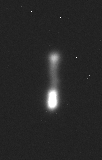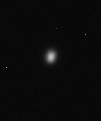

The polar alignment was about as perfect as is achievable so that was not the problem. Attempts to refine the PEC curve did not improve matters, the newly generated PEC curves matched those calculated previously, so that was not the problem.
Close inspection revealed that the drift was entirely in RA, the answer then became clear. I had re-arranged the cables on the telescope and re-balanced it, but now it was perfectly balanced and the drive was jumping. A series of test were done to test out this hypothesis, shown below:
The telescope was set up with the tube on the East side of the mount and the weights on the West. 5min exposures were taken, except were stated otherwise. All exposures taken at f11 on QSI 532ws camera.

Total drift in RA 77 pixels, width of trace 12 pixels.
Drift is therefore 15.4 pixels per minute, ( 5.5 arcsec/min).
Bounce in the drive can be clearly seen, but there is also a periodic error component.
Total drift in RA 48 pixels, width of trace 12 pixels.
Drift is therefore 9.6 pixels per minute, ( 3.45 arcsec/min).
The majority of the signal is within 42 pixels, which would be a drift of 2.1 acrsec/min.
Total drift in RA 63 pixels, width of trace 12 pixels.
Drift is therefore 12.6 pixels per minute, ( 4.5 arcsec/min).
This has exagerated the bounce in the drive although interestingly the drift is less than with perfect balance.
Total drift in RA 48 pixels, width of trace 12 pixels.
Drift is therefore 9.6 pixels per minute, ( 3.4 arcsec/min).
But, the majority of the signal is within 28pixels, a drift of 3.2 pixels/min, (1.15 arcsec/min)
There is still some bounce in the drive, but it is clearly much better. The rest is periodic error.
PEC on, slight decrease in weight on counterweight side, - motor is now lifting the telescope tube.
Total drift in RA 2.5 pixels, width of trace 12.5 pixels.
Drift is therefore 2.5 pixels per minute, ( 0.89 arcsec/min).
Need to try a 5min exposure when next out and adjust the balance further.
I have now started to use a Lodestar Guide camera and an off axis guider (OAG). I have two of these, one is and old one that I had from the days of guiding by eye, and the other is a QSI OAG for my QSI camera. Both work very well, the QSI system is a bit lighter and has a larger prism in it so this is the one of choice.
The OAG unit, combined with the experienced gained above now gives me perfectly round stars when guiding for 5 minutes or more on the C14. I am not totally convinced by the Lodestar, my model at least does have some issues, but it does do the job when all is said and done. I do not like the connector for the guider port, and I do not seem to be able to use more than one USB extender lead even with a USB hub. I have got round this issue to some extent by using an adaptor that converts the system into an ethernet connection, but this does generate some artifacts. The best solution is to have another computer by the telescope, but as I am trying to run this totally from inside the house, it is not really something that I find satisfactory.



